Script:
Scene 1
Stephen: (pretends to be crying)
Kenneth:
* Walks pasts Stephen and sees him crying*
*stops and switches the button to the “logical” side
*changes attitude*
Kenneth: Hey, I see you’re upset, do you want to talk about what happened?
Stephen: Yes, I can’t finish my recitation blogs. They are too long. It was like at least 800 words for each blog. I can’t take it any more.
Kenneth: I finished mine a really long time ago. You should catch up, you’re so slow.
Stephen: you’re so mean, “switches knob for emotional side”
Kenneth: oh, I can relate. It’s all going to be fine, I can help you do it!
Stephen: thanks bro *hugs me*
Scene 2
Flora: *trips Freddie*
Freddie: *falls and cries*
Tawan: *puts the helmet on*
*switches the button to the logical side*
*changes attitude*
“Next time you should calculate the possibility of that happening so this wouldn’t happen to you again.”
Freddie: How am I supposed to know what she’s going to do?
Tawan: “There’s a high probability that your friend would prank you, 70% to be precise. Your mental capability is just not high enough to see that coming”.
Freddie: “You know that most people would be helping me instead of lecturing me about what to do right?”
Tawan: “Emotions are temporary. Logics are permanent. People can change emotions, but they can’t change facts. I am telling you what to do so you can think more rationally instead of crying like a baby”.
Freddie: “I don’t like you”.
Tawan: *switches the button to the emotional side*
“I’m so sorry bro I don’t know what came over me, you good?”
Freddie: “Yea I’m okay bro, thanks for asking”
Tawan: *holds out his hand to Freddie and helps him get up*
Scene 3
Stephen : *puts the helmet on with the emotional mode*
Freddie: Why don’t we go out tonight?
Stephen: Yay, lez goooo! Where are we going? Clubbing?
Freddie: Yeah, but I really don’t feel like clubbing, maybe dinner?
Stephen: *switches his helmet to the logical side*
Stephen: Yes, that sounds better. We have a lot of interaction lab homework to do. It’s a Wednesday night, Freddie.
Freddie: You’re right, we should finish all of our work today. You are so logical!!
Recording & Reflection:
Our invention was the Logic/Emotion Head Band, which derived from the second article “The Ones Who Walk Away from Omelas” by Ursula K. Le Guin. We first read through the invention proposals by everyone of the group. Within the group, we voted to judge on the inventions of best interests and the ones of most practicality, namely, the ones that were most practical to be turned into prototypes with cardboards only. It turned out that my third invention, a capsule to isolate people from the outside world was innovative but not so practical as Kenneth’s and Tawan’s second inventions, which were similar to one another, two helmets. Kenneth’s helmet was to create a virtual reality inside the helmet for users, but its functions overlapped with the already-invented VR contacts or lenses. Thus, we chose a more advanced invention, Tawan’s Logic/Emotion Head Band. In the given story, emotions in Omelas was officially defined by the knowledged and the experienced. With the band, people could have control over the emotional and logical ratios of thinking pattern, so when they need to think logically they could turn the logic switch to a large value while if they need to proceed things emotionally, to say, when they need empathies, they can turn the switch of emotion to a larger portion. The interactions of the machine stays not only on the special switches, but also, goes deeper into the neural system of human brain, the objective command of the brain’s processing pattern. It changes with the brain’s changing import. It was not a one-direction information export, but an inter-relation, interaction.
As was described by the inventor, “this helmet will allow you to adjust your logical thinking and your emotional thinking by adjusting a knob.” So far, no machine has been able to bring ion changes to the thinking pattern to human beings, apart from those that destroy certain parts of our brains. Whereas helmets might be too common for this project, because too many different functions could be applied to them while they are not that convenient to carry around. Thus, we decided to produce a head band, easier to carry around and easier to make. So, by using my head as a sample, they first cut out a cardboard bend to wrap around my head.
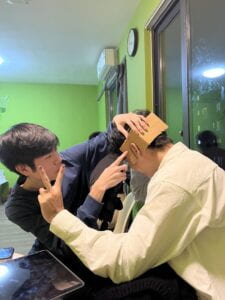

For it to be stable on the head when using, we need to leave space for ears on the bend so that the bend could be hooked on ears. As all of us had different size of heads, I proposed that the bend’s length could be made adjustable, which was to add a link on the fore head part to let it be flexible in length. 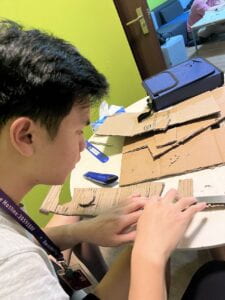 It was the very prototype of the prototype. To get into the details of it, we needed a blue print. Thus, Kenneth did his part to make sketches that we decided on his iPad.
It was the very prototype of the prototype. To get into the details of it, we needed a blue print. Thus, Kenneth did his part to make sketches that we decided on his iPad. 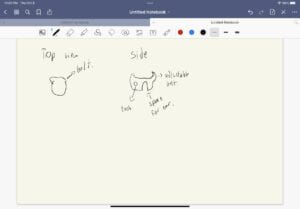
Later on, we started to decide on the details of the band, how the adjusting link and the two switches should be designed to construct the whole of the band. 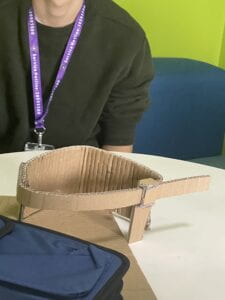 Here is the link of the adjusting of ht size of the band;
Here is the link of the adjusting of ht size of the band;
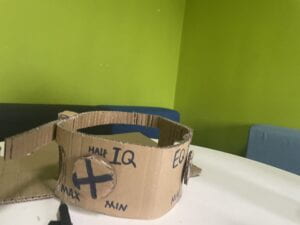 Here is the switches that we designed. We thought of how to make these switches for long and finally we came to an agreement that we use a short stick to go through the band to stable the round switch while giving them enough freedom to turn. However, they fell off easily at first, so we have to thought of another way for them to stay. We stuck two round card boards on the other side to keep the switches on the band. It took us three days to think of it and finish it. Then, what came forth would be a rather big task, to show without telling, namely, the group performance.
Here is the switches that we designed. We thought of how to make these switches for long and finally we came to an agreement that we use a short stick to go through the band to stable the round switch while giving them enough freedom to turn. However, they fell off easily at first, so we have to thought of another way for them to stay. We stuck two round card boards on the other side to keep the switches on the band. It took us three days to think of it and finish it. Then, what came forth would be a rather big task, to show without telling, namely, the group performance.
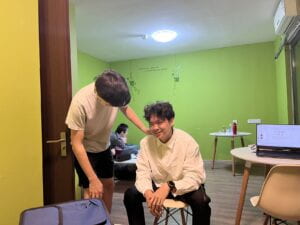
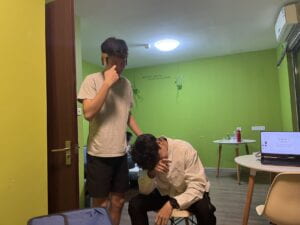
I came up with the first scenario that was to show someone crying of certain business while the user of the band came to react. What I needed to show was the change, what would happen if logic conquered the mind and what would happen if emotion filled the mind. I played the role as the crying guy. I reflected on it and realized quite a problem, at the same time I was showing the function of the band, I was also showing the weaknesses of the band, that the adjustment of the switches depends on both the user and others, but people who use it might not be able to tell how they should adjust the switches according to different situations, and might be trapped in the same thinking pattern forever.
But we showed the bright sides of it later on with scene 2 and scene 3. Logic and emotion, empathy and discipline, they all showed their own strengths and short comings in different fields. But being able to jump between logic and emotion corresponding to situations could improve the deciding process by large. In scene 2, Tawan and Flora showed the differentiated effects of such, predicting the future and empathizing the wretches. In scene 3, I played the role of the student pleasure seeker, but with the band bring the change of thinking pattern to me, I could push myself back to the right trail, to work on academics prior to clubbing and drinking. With the band, I not only changed myself but also people around me, to say, Freddie who acted as a cross-bencher between pleasure-seeking and studying and was led to do his homework as he was supposed to.
The group I would like to analyze and assess was the second group which made a surveillance and crime-detecting glasses device. The invention emerged from the first story around a futuristic delusional VR device which got people drowned in the very scene it created. The invention was relevant to the story, because the lenses could record what the user had seen and create a deja-vu for the user to rewatch. As the scene created was similar with the delusions created by the device in the story. It was interactive because it captured the vision of the users. Moreover, it could detect crime with certain AI algorithms under human criterion. Its interaction relies not only on the users but also the outside world and different scenarios of it. The invention was very advanced and innovative. But what’s more innovative washer the group performed. The members did a slow motion plot in the end to show how the crime was captured, which was never seen in any other peer performances. Films could do that by slowing the flow of pictures, but they actually slowed down their motions to make it happen, which stroke me as quite a surprise for immediate performance. What I found as a slight problem to the intention of the product was that the supervisory control has already been developed nowadays, and that it doesn’t seem very necessary that we need a pair of lenses to capture the things that happened. Thus, what’s the advance of the product would be the algorithms of surveillance and crime capturing.